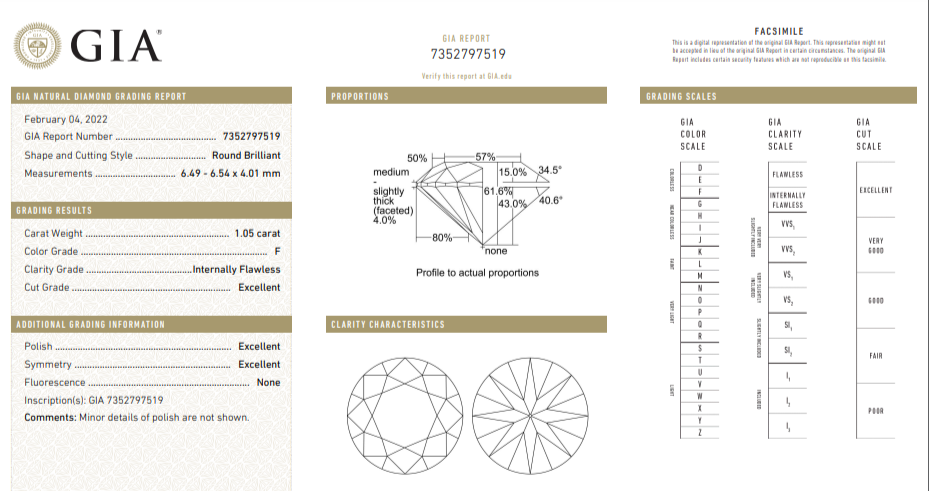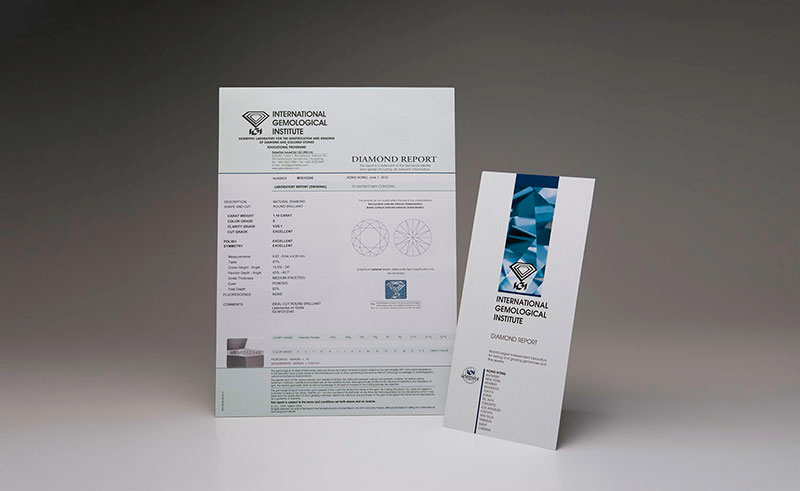This site is reader-supported. For more information, please visit the Disclosure page.
Obtaining confidence in the diamond you’ve chosen is ultimately a crucial component of any worthwhile diamond investment. Many of us rely on brand names, especially when buying something with a large price tag, like a new television or a car. Brand names are worthwhile in every industry, but in the world of diamonds, one thing trumps a name: certification.
That’s where the International Gemological Institute (IGI) and the Gemological Institute of America (GIA) come in. These are both well-respected institutes that offer impartial grading and certification of diamonds, giving customers an unbiased and trustworthy view of what they’re buying.
Our topline recommendation is — if a diamond doesn’t have accredited certification, don’t buy it.
However, the IGI and the GIA are different organizations and so the way they work is different. Different how? We’ll explain.
How Diamond Certification Works
Diamond certification or diamond grading reports are provided when you find a diamond you’re interested in. In most cases, these are accessible on the diamond’s webpage (if you’re looking at diamonds online). In other scenarios, these can be accessed in person. For example, look at this 1.05-Carat Round Cut Diamond from Blue Nile, where you can access its GIA report just by scrolling down the page.

Here’s a screenshot of the report in full. It includes detailed descriptions of the diamond’s:
- Proportions
- Carat weight
- Color grade
- Clarity
- Cut grade
- Polish
- Symmetry
- Measurements
AS you can see, they’re incredibly useful for seeing the specific characteristics of the diamond, characteristics you can’t necessarily tell just by looking at a photo or video.
So, out of the IGI and the GIA, whose reports should you trust?
The IGI
The IGI operate mostly in Europe and Asia (American markets are where you will predominantly find the GIA). They are one of the most well-known diamond certification labs operating today, partly due to the fact they offer lower prices and rapid turnaround times. The partnerships they’ve fostered with many diamond retailers and manufacturers across the globe have been very productive, and in many cases, their work and research have helped further the diamond market through knowledge and education sharing.

However, speed and cheaper prices do come with their downsides. We’ve seen reports of diamonds not having the right appraisals given, and when the same diamond has been reviewed by the GIA, for example, they’ve found it to be of a lesser quality than the IGI originally deemed correct.
We’re unsure of the reason for this — it could have occurred through human error or through inconsistencies between lab operations. Whatever the reason, it’s worth remembering this kind of weakness and why it’s important.
IGI Lab-Grown Diamond Grading: Consistent and Respected
That said the IGI is highly regarded for its meticulous grading of lab-grown diamonds. The grading process begins with assigning a unique IGI identification number to ensure anonymity and impartiality. Each diamond undergoes compulsory screening using advanced technology to determine its origin. The evaluation includes precise measurements, color grading in a standardized environment, and clarity assessment at 10x magnification. Multiple gemologists independently verify each step to ensure accuracy. Finally, a laser inscription and a detailed grading report, with security features, guarantee the diamond’s quality and authenticity.
Why Are Inconsistent Grading Reports Bad?
Legitimate certification is the only thing that truly guarantees a good investment. If a certification lab has inconsistency within its reports, there’s a chance that what you’ve bought isn’t what was described. When purchasing a diamond, either for the first time or the hundredth time, being able to compare and contrast options is key, and this is where consistent grading reports are important.
If a diamond certificate is either incorrect through human error or is knowingly inflating the quality of the diamond, you might end up paying more than the diamond is worth. It doesn’t necessarily mean that the diamond you buy is a bad diamond (as ever, you can usually look at diamonds for yourself before buying), but would you really want to spend more than what it’s worth? I would personally look elsewhere and take more time before investing, rather than spending 20% or more over what I should be paying.
The GIA
The GIA are one of the most prominent diamond certification labs in the world. Its research has been used to further the expertise of diamond manufacturers and retailers the world over. If a diamond has GIA certification, you can trust that what is described is what you get. Some of my favorite diamond retailers, James Allen, Brilliant Earth, and Whiteflash, use get their diamonds certified by the GIA. They were instrumental in developing the things we take for granted today, such as the diamond color scale.
All in all, their reports aren’t too dissimilar from the ones supplied by the IGI. As you can see from the example above, they provide detailed information on diamond characteristics such as measurements, proportions, and the all-important Four Cs. In my opinion and the opinion of many others, the GIA is by and far the most trustworthy of all independent diamond labs offering certification today.
The GIA’s certification process is a little more expensive than the IGI, so you may find that GIA-certified diamonds tend to average at a little more expensive than those graded by the IGI.
The IGI vs. The GIA
In all, the GIA is seen as a higher-quality independent lab than the IGI. As I said before, there have been reports of the IGI being ‘looser’ with how they grade, and in some circumstances, diamonds have been found to be graded higher than they should have been.
I’m under the impression that, because the IGI has a variety of labs placed around the world (both in Europe, America, and Asia), that is why there can be inconsistency and discrepancy in said gradings.
If you’re able to secure a diamond with a GIA grading report, then you can rest easy knowing that the diamond you’ve chosen matches the description it has been given. And if you’re paying a large price, such as over $10,000, this is all the more important.
If I had to choose, I would always go with a GIA-certified diamond over an IGI. That being said, IGI diamonds can still be fantastic choices, but it may be worth putting a little more due diligence into your searching process.
The GIA’s grading standards are known as some of the most rigorous on the market and are consistently reliable over time. However, the IGI has also been found to have very rigorous standards according to a survey carried out by the Rapaport Diamond Trading Network. The GIA and IGI scores suggested that “the U.S.-based labs are working within comparable boundaries, while the non-U.S. labs are applying more lenient standards”.
This may mean that if you can source an IGI diamond that’s been certified in the US, you won’t have any issues with inflated diamond quality. However, there is also the argument that a US lab may take the grading of a European lab at face value, rather than having their own look to judge the accuracy of said report.
The GIA always gives diamonds a new examination, which is a huge advantage. When it comes to accurate diamond grading, impartiality and objectivity are key.
Is a Diamond Report Enough?
While a diamond report or certificate provides valuable information about a diamond’s 4 Cs (carat, color, clarity, and cut) and serves as a sign of trust, it has limitations. Reports often lack detailed images or videos that truly represent the diamond’s appearance. To make an informed purchase, choose a vendor that offers high-quality images, HD videos, and light performance images. These tools provide a comprehensive view of the diamond, ensuring you know exactly what you’re buying. This combination of certification and visual evidence helps you make a confident, well-informed decision.

Richard Jenkins, The Diamond Guru
Get free assistance from the Diamond Guru today. You’ll be glad you did!
- Secure the best quality diamond for your budget.
- Don’t pay over the odds for your diamond ring.
- Have peace of mind that you didn’t get ripped off.
Have a Question? Contact us now…

